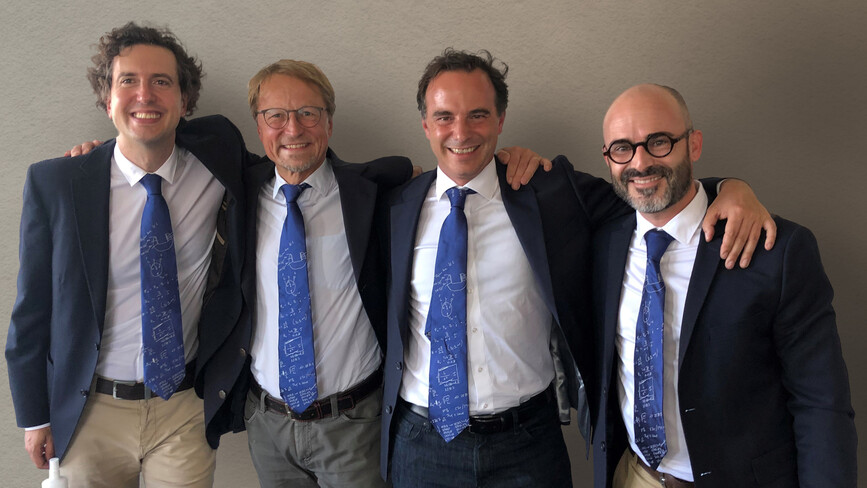13 million euros for basic quantum research
05.11.2020
Even after more than 100 years of their discovery, the laws of quantum physics sometimes seem in contradiction to common sense. Most prominently, the superposition principle states that a single object can behave as if it were in several places at once. This behaviour is confirmed in milestone experiments: at the scale of elementary particles, atoms and even molecules containing thousands of atoms. But is this also true for the macroscopic domain, say for solid state objects visible to the naked eye? In answering this question, the Austrian-Swiss research team, supported by the EU’s Synergy Grant, now wants to take a big step forward. “We want to put a nanoparticle consisting of billions of atoms into a large superposition state,” says project coordinator Oriol Romero-Isart from the Department of Theoretical Physics at the University of Innsbruck and the Innsbruck Institute of Quantum Optics and Quantum Information (IQOQI) of the Austrian Academy of Sciences, describing their common goal.
Reaching the goal together
Over the last years, the four researchers have developed new experimental and theoretical techniques to levitate and control such nanoparticles in the quantum regime in individual ERC projects. “We combine our know-how in fundamental science, nanotechnology and engineering to create a radical new approach to this question”, says experimental physicist Markus Aspelmeyer Director of IQOQI Vienna and professor at the University of Vienna. In a joint effort, they will study the nanoparticles in a high vacuum, its center-of-mass motion cooled down to near absolute zero and levitating in a combination of optical, electric, and magnetic fields. “With this project, we are pushing the limits of what is technically feasible today”, adds Romero-Isart.
Since 2012, the European Research Council (ERC) has been using Synergy Grants to support research projects in which researchers join different expertise to achieve a goal that has so far been out of reach for science. After a multi-stage evaluation process and in competition with hundreds of other projects, the ERC now supports the Q-Xtreme research project conducted by the four physicists in Innsbruck, Vienna and Zurich.
Potential for Quantum Sensors
Such quantum superpositions are very fragile and are sensitive to external influences such as inertial forces and gravity. It will therefore also be possible to use the experiments to analyze the influence of gravity on quantum superpositions. In addition, they will enable the development of sensitive measuring instruments for acceleration, rotation or gravity. The experiments will be carried out at the University of Vienna and at ETH Zurich; Romero-Isart’s group in Innsbruck will complement the project with theoretical work.
There is even an historic component: the Austrian physicist and Nobel laureate Erwin Schrödinger ridiculed the possible consequences of such ``macroscopic superpositions" in his famous cat paradox. “Given the fact that Schrödinger held professorships at Vienna, Innsbruck and Zurich it seems the adequate place to conduct these experiments”, smile Aspelmeyer and Romero-Isart.
Excellence Program
With the Synergy Grants, the European Research Council supports pioneering frontier research by teams of two to four outstanding researchers. Scientific excellence is the sole criterion for the evaluation and selection of projects. The projects should lead to discoveries at the intersections between established disciplines and to substantial progress at the frontiers of knowledge. Depending on the respective research project, ERC Synergy Grants amount to up to 14 million Euros for a duration of up to six years.
About the ERC
The European Research Council, which was established by the European Union in 2007, is the most important European funding organization for excellent frontier research. Each year, it selects and funds the very best, creative researchers of all nationalities and all ages to carry out projects in Europe. The ERC has three funding programmes for individual researchers - Starting Grants, Consolidator Grants and Advanced Grants - and Synergy Grants for small groups of excellent researchers.
Links:
European Research Council (ERC):
Research group Oriol Romero-Isart:
iqoqi.at/en/group-page-romero-isart
Research group Markus Aspelmeyer:
https://aspelmeyer.quantum.at/
Research group Lukas Novotny
https://www.photonics.ethz.ch/
Research group Romain Quidant
Contact:
Oriol Romero-Isart
Institute for Theoretical Physics
University of Innsbruck &
Institute for Quantum Optics and Quantum Information
Austrian Academy of Sciences
Phone: +43 512 507 4730
e-mail: oriol.romero-isart@uibk.ac.at

